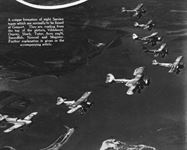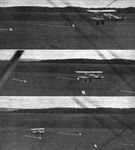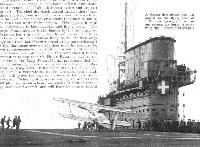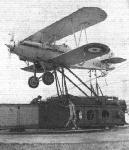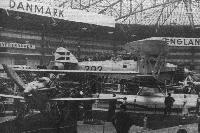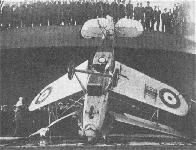
Варианты
- Hawker - Hornet / F.20/27 - 1928 - Великобритания
- Hawker - Fury - 1931 - Великобритания
- Hawker - Nimrod - 1931 - Великобритания
- Hawker - PV.3 - 1934 - Великобритания
- Isaacs - Fury - 1963 - Великобритания
Hawker Nimrod
В период с 1924 по 1932 годы Fairey Flycatcher оставался единственным истребителем авиации британских ВМС. Однако его низкая скорость - всего 214 км/ч - и незначительный практический потолок уже не удовлетворяли требованиям, поэтому было решено найти ему замену.
В 1926 году по техническому заданию Министерства авиации компания "Hawker" предложила в качестве палубного истребителя биплан Hoopoe. Однако эта машина не устроила адмиралов, но затем на базе полученных наработок был спроектирован самолет Fury, а уже на его базе появился новый истребитель-биплан, первоначально названный Norn. Впоследствии он получил обозначение Nimrod, первый серийный образец самолета поднялся в воздух 14 октября 1931 года. В течение 1932 года Nimrod Mk I заменили в британской морской авиации самолеты Flycatcher (перевооружению подверглись 402-е, 408-е и 409-е звенья). В 1933 году новые машины поступили в 800-ю эскадрилью, приписанную к авианосцу "Корейджес", и 801-ю и 802-ю эскадрильи, приписанные к авианосцам "Фьюриес" и "Глориес" соответственно.
Выпуск усовершенствованных вариантов Nimrod Mk II начался в сентябре 1933 года, первые поставки в морскую авиацию осуществлены в марте 1934 года - данные машины имели посадочный гак, более мощные двигатели и хвостовое оперение большей площади. Многие из 57 самолетов Nimrod Mk I были позже модифицированы в стандарт Mk II. Причем силовая конструкция первых трех самолетов Mk II была выполнена из нержавеющей стали, а в оставшихся 27 серийных машинах вновь стали использовать стандартную для компании "Hawker" конструкцию из легких сплавов и стали.
Компании не удалось получить значительные заказы на экспорт самолетов этого типа. Один был поставлен в Японию, один - в Португалию и два - в Данию, где они получили обозначение Nimrodderne. Планировалось выпустить по лицензии еще 10 самолетов в Дании, но, скорее всего, ни одну машину датчанам собрать не удалось.
Самолеты Nimrod с началом Второй мировой войны перевели на решение учебно-тренировочных и связных задач, но самолеты продолжали эксплуатироваться до июля 1941 года, когда уже окончательно были объявлены устаревшими и быстро списаны. Датские Nimrodderne продолжали использоваться до германского вторжения в апреле 1940 года.
ТАКТИКО-ТЕХНИЧЕСКИЕ ХАРАКТЕРИСТИКИ
Hawker Nimrod Mk II
Тип: 1-местный палубный истребитель
Силовая установка: один V-образный ПД Rolls-Royce Kestrel IIS мощностью 477 л. с. (356 кВт), позже замененный на V-образный ПД Kestrel VFP мощностью 608 л. с. (452 кВт)
Летные характеристики: максимальная скорость на высоте 3660 м - 315 км/ч; крейсерская скорость на оптимальной высоте 185 км/ч; набор высоты 3050 м - за 6 мин 8 с; практический потолок 8200 м; продолжительность полета 1 ч 40 мин
Масса: пустого 1413 кг; максимальная взлетная 1841 кг
Размеры: размах крыла 10,23 м; длина 8,09 м; высота 3,00 м; площадь крыла 27,96 мг
Вооружение: два 7,7-мм пулемета Vickers Mk III вверху носовой части фюзеляжа, плюс до 36 бомб на подкрыльевом узле подвески - обычно четыре 9,1-кг бомбы.
- Описание
Фотографии
-
Мировая Авиация 153
Регистрационный номер: S1630 Этот Nimrod принадлежал 802-й эскадрилье, дислоцированной на авианосце "Глориес". Эскадрилья вооружалась самолетами Nimrod в течение 1933 года, а в 1939 году их сменили истребители Sea Gladiator
-
Мировая Авиация 19
Hawker Nimrod. Истребитель Nimrod был приписан к 2-й воздушной флотилии Marine Flyvevaesenet (морской авиации). Из 12 самолетов Nimrod, имевших в датском ВМФ обозначение L.B.V, два были произведены фирмой "Hawker", остальные построены по лицензии на датском заводе "Orlogsvaerfte". Истребители Nimrod подлежали замене на самолеты Macchi МС.200, заказанные в Италии, но еще не полученные.
-
Авиация и Космонавтика 2012-10 / М.Путников - "Летающие легенды" - 2012
Регистрационный номер: K3661 [3] Хоукер "Нимрод"
-
Мировая Авиация 222
Восстановление данного Hawker Nimrod Mk II до годного к полетам состояния в 1990-е годы потребовало нескольких сотен часов работы и десятков тысяч фунтов стерлингов. Самолет принадлежит организации "The Fighter Collection" из Южной Англии.
-
Aviation Historian 19 / P.Jarrett - The Hornet dilemma
It has been suggested that the Hawker Norn, the prototype for the Nimrod naval single-seat fighter, might have been used as the demonstrator during the 1931 Balkan tour, but this seems unlikely, as it was heavily involved in Fleet Air Arm trials by that time. The Norn is seen here in November 1930 during its A&AEE trials.
-
Flight 1933-10 / Flight Advertisements
Hawker Nimrod (Rolls-Royce "Kestrel" Engine)
-
Jane's All the World Aircraft 1938 / 03 - All the world's aeroplanes
Регистрационный номер: K2840 [2] The Hawker "Nimrod" Single-seat Fleet Fighter (Rolls-Royce "Kestrel" engine).
-
Aeroplane Monthly 1991-09 / Personal album. Military
Регистрационный номер: K3661 [3] Hawker Nimrod K3661 of 802 Sqn. It was delivered to the RAF towards the end of 1934. The type was powered by a 590 h.p. Rolls-Royce Kestrel IIS. No 802 Sqn hung on to theirs until May 1939, the type being declared obsolete in 1941!
-
Flight 1938-05 / Flight
Регистрационный номер: K2827 [2] HAWKER NIMROD: Fleet fighter (Kestrel IIS engine - 550 h.p. at 13,000ft.); span, 33ft. 6 1/4 in.; gross weight, 4,042 lb.; max. speed, 181 m.p.h. at 16,400ft.
-
Flight 1931-03 / Flight
AIRCRAFT TYPES TO BE SEEN IN THE "EAGLE": 4, The Hawker "Nimrod," also with "Kestrel" engine.
-
Flight 1935-06 / Flight
The Hawker "Nimrod" is a single-seater fleet fighter with the fully supercharged 525 h.p. "Kestrel IIS."
-
Flight 1935-06 / Flight
The Plummer: A "Nimrod" fleet fighter enters a terminal velocity dive in which it will reach a speed in the region of 400 m.p.h.
-
Flight 1933-10 / Flight Advertisements
SECURITY. - A unique photograph taken by "Flight," showing the Hawker "Nimrod" piloted by Mr. Bulman just after commencing a T. V. dive. This is one of the many rigid tests to which Hawker aircraft are subjected both before and during Service.
-
Aeroplane Monthly 1992-01 / J.Fozard - Camm's engine legacy
Регистрационный номер: K3658 The FAA's counterpart of the RAF's Fury was the Hawker Nimrod, powered by the Rolls-Royce Kestrel IIS. Seen here is Nimrod II K3658.
-
Aeroplane Monthly 1989-04 / Personal album. Military
Регистрационный номер: K4620 Pleasant air-to-air photograph of Hawker Nimrod II K4620. One of a batch of ten delivered in October/November 1935, K4620 was first delivered to 801 Squadron and later passed to 800 Squadron. On January 8,1937 it crash-landed at Southampton. The Nimrod entered service with the FAA in 1932, replacing the Fairey Flycatcher. Nimrod IIs were fitted with arrester-hooks and had larger tail surfaces than Mk Is. Armament consisted of two fixed, synchronised Vickers guns and there was provision for carrying four 20lb bombs below the wings.
-
Мировая Авиация 115
Регистрационный номер: S1582 [2] В 1933 году в частях британской авиации ВМФ произошла реорганизация. Звенья свели в эскадрильи (по три в каждой), которым присвоили номера, начинавшиеся с цифры 800. Nimrod служили в двух звеньях в 800-й (фото) и 801-й эскадрильях (авианосец "Корейджес"), а также в эскадрилье № 802 (авианосец "Фьюриес"), Третьи звенья эскадрилий оснастили самолетами Hawker Osprey. К началу Второй мировой войны почти все Nimrod были списаны и заменены на истребители Gloster Sea Gladiator и Blackburn Skua. На экспорт ушли всего четыре Nimrod: два - в Данию, один - в Японию и один - в Португалию.
-
Air-Britain Aeromilitaria 1978-02
Hawker Nimrods of No.408 Flight over Grand Harbour on 17 May 1932. The lead aircraft carries a checkerboard identification on the centre-section.
-
Flight 1932-10 / Flight
RARELY have we had the privilege of publishing photographs of such a perfect formation flying as that depicted here. They show No. 408 Fleet Fighter Flight, of H.M.S. "Glorious," commanded by Lt.-Com. E. M. C. Abel-Smith, R.N. The aircraft are Hawker "Nimrod" fitted with Rolls-Royce "Kestrel" engines
-
Flight 1932-10 / Flight
Регистрационный номер: S1585 -
Aeroplane Monthly 1991-09 / Personal album. Military
Регистрационный номер: K3661 [3], K4627, S1587 A formation of three 802 Sqn Nimrods - K3661, K4627 and S1587. The same three aircraft are depicted right.
-
Air-Britain Aeromilitaria 1980-03
Регистрационный номер: K2826, K2840 [2], S1582 [2] A trio of No.800 Squadron's Nimrods, K2840(103), S1582(102) and K2826(106) over Courageous
-
Aeroplane Monthly 1994-12 / G.Wansbrough-White - What's in a name? (2)
A formation of eight types based at Gosport in 1938. They are, from the top, Vildebeest, Osprey, Shark, Tutor, Avro 504N, Swordfish, Nimrod and Magister. The 504N was flying at full bore while the Kestrels of the Nimrod and Osprey were throttled well back. Pilots of this “Heinz” formation were drawn from the RAF, Army, Navy and Marines; the aircraft came from the Coastal Defence Development Flight and the Torpedo Training Unit.
Другие самолёты на фотографии: Avro Avro 504N - Великобритания - 1920Avro Tutor/Sea Tutor/Prefect / Type 621/646/626 - Великобритания - 1929Blackburn Shark / B-6 - Великобритания - 1933Fairey Swordfish - Великобритания - 1934Hawker Osprey - Великобритания - 1930Miles Magister / M.14 - Великобритания - 1937Vickers Vildebeest / Type 132 - Великобритания - 1928
-
Flight 1938-05 / Flight
A unique formation of eight Service types which are normally to be found at Gosport. They are, reading from the top of the picture, Vildebeest, Osprey, Shark, Tutor, Avro 504N, Swordfish, Nimrod and Magister.
Другие самолёты на фотографии: Avro Avro 504N - Великобритания - 1920Avro Tutor/Sea Tutor/Prefect / Type 621/646/626 - Великобритания - 1929Blackburn Shark / B-6 - Великобритания - 1933Fairey Swordfish - Великобритания - 1934Hawker Osprey - Великобритания - 1930Miles Magister / M.14 - Великобритания - 1937Vickers Vildebeest / Type 132 - Великобритания - 1928
-
Aeroplane Monthly 1991-09 / Personal album. Military
Mr Leslie Hore-Belisha leaves Malta in de Havilland D.H.86B L7696, escorted by Hawker Nimrods of 802 Sqn, on April 22,1938. As Secretary of State for War, Hore-Belisha had spent four days on the island inspecting the various defences.
Другие самолёты на фотографии: De Havilland Express Air Liner / D.H.86 - Великобритания - 1934
-
Flight 1938-07 / Flight
These three photographs show three stages in practice landings on a dummy deck marked out on the aerodrome at Leuchars. Though the conditions are not identical with those of landing on a moving carrier the practice is still very useful to the pilots.
-
Air-Britain Aeromilitaria 1978-02
A Nimrod fighter tests the undercarriage to its limits in a heavy landing.
-
Flight 1937-06 / Flight
Регистрационный номер: K2911 [2] "Entry into the arrester gear at too high a speed throws a great strain on both the aircraft and the deck cables." This remark of the author's can be readily appreciated by a study of this photograph, which shows a Hawker Nimrod being checked by an arrester cable on the deck of an aircraft carrier.
-
Flight 1935-08 / Flight
Регистрационный номер: K2911 [2] Arrester gear is as old in its conception as the idea of landing on the deck of an aircraft carrier, though the early forms, which made use of sandbag-weighted ropes, did not prove very successful; consequently these systems were gradually dropped in the Fleet Air Arm as the technique of landing on a bare deck was improved. More recently other countries, America in particular, have revived forms of arrester gear, presumably on the score of higher landing speeds, and our photographs show the latest type of arrester gear which is being used by our own Naval air service. The pivoted hook under the rear end of the fuselage catches in the cables stretched across the deck.
-
Flight 1936-06 / Flight
A Nimrod fleet fighter has just landed on the flying deck of H.M. Aircraft Carrier Courageous, and airmen and seamen are hurrying to its wing tips. The bridge and funnels and other top-hamper are all contained in the structure on one side of the deck.
-
Jane's All the World Aircraft 1980 / Encyclopedia of Aviation - Aircraft A-Z - v3
Регистрационный номер: S1577 Hawker Nimrod I.
-
Flight 1935-08 / Flight
Pilotes of a Fleet Air Arm squadron which took part in the Air Exercises; the machines are Hawker "Nimrods" and "Ospreys."
-
Air-Britain Aeromilitaria 1980-04
Регистрационный номер: S1628 Nimrod S1628 on the catapult at RAF Base, Leuchars
-
Flight 1935-10 / Flight
Регистрационный номер: K3654 LEARNING AT LEUCHARS: A Hawker Nimrod about to be "fired" during catapult training at Leuchars.
-
Jane's All the World Aircraft 1938 / 02 - The progress of the world in military aviation during the year 1937-38
A Hawker "Nimrod" (Rolls-Royce "Kestrel") of the Danish Army Air Force.
-
Мировая Авиация 115
В 1933 году в частях британской авиации ВМФ произошла реорганизация. Звенья свели в эскадрильи (по три в каждой), которым присвоили номера, начинавшиеся с цифры 800. Nimrod служили в двух звеньях в 800-й и 801-й эскадрильях (авианосец "Корейджес"), а также в эскадрилье № 802 (авианосец "Фьюриес"). Третьи звенья эскадрилий оснастили самолетами Hawker Osprey. К началу Второй мировой войны почти все Nimrod были списаны и заменены на истребители Gloster Sea Gladiator и Blackburn Skua. На экспорт ушли всего четыре Nimrod: два - в Данию (фото), один - в Японию и один - в Португалию.
-
Flight 1937-01 / Flight Advertisements
HAWKER NIMROD FLEET FIGHTER (Rolls-Royce Kestrel III's ) adapted to the requirements of and manufactured under licence by the Danish Naval Air Service.
-
Flight 1934-08 / Flight
THE DANISH NAVAL AIR SERVICE STAND: In front is the Hawker "Nimrod" (Rolls-Royce "Kestrel") and behind that the "Dantorp" (Siddeley "Leopard.")
Другие самолёты на фотографии: Hawker Horsley / Dantorp - Великобритания - 1925
-
Jane's All the World Aircraft 1980 / Encyclopedia of Aviation - Aircraft A-Z - v3
Hawker Nimrod I seaplane.
-
Flight 1934-07 / Flight
Регистрационный номер: S1578 A MIGHTY HUNTER: A Hawker "Nimrod" (R.R. "Kestrel" II's) on floats. The "Nimrod" is the Standard fleet fighter of the RAF, and in its landplane form has a top speed of over 190 m.p.h.
-
Flight 1934-11 / Flight
Stainless steel construction: a Hawker "Nimrod" wing.
-
Aeroplane Monthly 1999-11 / M.Oakey, T.Harmsworth - News
Регистрационный номер: G-BWWK, S1581 A GENUINE single-seat Hawker biplane fighter from the 1930s, in the shape of Hawker Nimrod S1581/G-BWWK, will take to the air again in the next few months following a six-year restoration by Aero Vintage in East Sussex. After test flying, it will move to Duxford where it will be based with the Fighter Collection.
-
Aeroplane Monthly 1973-07 / Personal album
Регистрационный номер: S1635 Hawker Nimrod I S1635, which served with 802 and 800 Squadrons in Courageous, hit the ship's superstructure on February 23, 1937. Visible damage includes a punctured port wheel, broken propeller and severely "bent” port wing-tips.
-
Aeroplane Monthly 1973-07 / Personal album
Nimrods seemed to be attracted by superstructure. This accident bears close resemblance to that in previous picture, although the starboard undercarriage legs seem to be in need of support.
-
Aeroplane Monthly 1973-07 / Personal album
Регистрационный номер: K2912 [2] -
Aeroplane Monthly 1973-07 / Personal album
Регистрационный номер: K2912 [2] Nimrod II K2912 went into store in the Mediterranean area in September 1935 and then entered service with 800 Squadron in Courageous from March 1936. On September 1 of that year it force-landed in the sea and is seen after the retrieval, shown in picture. The starboard underwing bomb carrier is well displayed.
-
Aeroplane Monthly 1976-12 / Personal album
Регистрационный номер: S1624 Captioned "Rupert on his nose due to arrester cable breaking, Malta 1932", this shows Hawker Nimrod S1624 of the second production batch, probably with either No 800 or No 801 Sqn aboard Courageous. Powerplant was a 477 h.p. Rolls-Royce Kestrel lls in-line.
-
Aeroplane Monthly 1989-04 / Personal album. Military
Регистрационный номер: K2913 Two views of Hawker Nimrod II K2913 taken after a minor incident, resulting in very slight damage. One of a batch of six Nimrods supplied in October 1934, K2913 flew with Nos 800 and 801 Squadrons. It was lost in a crash off Bembridge, Isle of Wight on Marsh 22, 1937. The “blood wagon", probably painted in the standard blue/grey scheme of the period, bears on its side the legend, “To Carry 1 Driver, 1 Attendant and 8 Patients”.
-
Flight 1935-12 / Flight
A Nimrod which, fitted experimentally with wing flotation bags, has overturned on being "ditched." Nimrods do not normally carry the type of gear shown.
-
Aeroplane Monthly 1996-03 / Skywriters
Регистрационный номер: S1634 Hawker Nimrod S1634 spun in near Rosetta, 30 miles east of Alexandria and not Aboukir as previously stated. Fg Off Stewart, pilot of Nimrod K2825 was killed.
-
Air-Britain Aeromilitaria 1980-04
Регистрационный номер: S1583 Nimrod S1583 of No.408 Flt on the foredeck of Glorious 5.2.32
-
Aeroplane Monthly 1976-03
Регистрационный номер: K2827 [2] Hawker Nimrod No 801 Squadron HMS Furious 1934
-
Aeroplane Monthly 1979-07 / Painted Wings
Edmund Miller's portrayal of a Hawker Nimrod, entitled “Fleet Fighter”
-
Flight 1935-12 / Flight
This installation of atmospheric bags is in the Hawker Nimrod fleet fighter
-
Flight 1935-12 / Flight
This series of sketches, specially prepared by Flight, shows the various types of gear and the flotation angles of certain R.A.F. machines. Those fitted with Youngman dinghies, of course, do not sink immediately.
Другие самолёты на фотографии: Fairey Swordfish - Великобритания - 1934Hawker Hart - Великобритания - 1928Hawker Osprey - Великобритания - 1930Vickers Vildebeest / Type 132 - Великобритания - 1928
- Фотографии






















